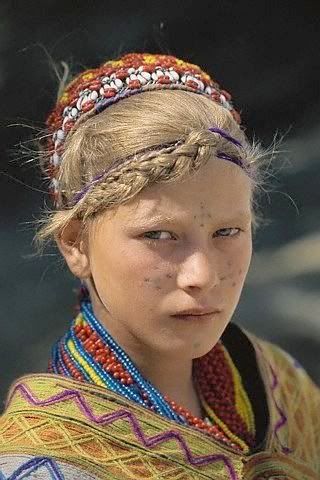Vad är ödet för ett folk som inte kan eller vill försvara sitt urhem, hur framlever ett sådant folk sina sista dagar? Detta är sannolikt inget dagens svenskar frågar sig, överhuvudtaget är deras egna barnbarns öde något fullständigt ointressant för dessa hedonister i deras eviga ”nu-tillstånd” (även det begränsade utrymme miljöfrågorna får bevisar hur minimalt våra samtidas intresse är för deras egna barnbarns, eller ens deras egna barns, framtid).
För den som inte fastnat i ett evigt nu, finns det däremot exempel på folk som förlorat kontrollen över sitt eget hemland, och som lever som kulturella reliker. Ett sådant folk är det lilla kalash-folket, från Pakistan. Kalash är indo-europeiska hedningar, som tydligen ska ha en religion som påminner om den tidiga vediska (ursprunget till dagens hinduism, lite förenklat).
Mer om våra kusiner i den fjärran östern, Kalash, finns att läsa i denna tråd på Skadi: The Kalash People, med ett flertal bilder. Det kan tilläggas att ”kafir”, som tydligen kalash ibland kallas av sina muslimska grannar, är ett negativt laddat uttryck, och betyder ”otrogen”. Kanske inte lika negativt laddat som ”kuffar” eller n-ordet, men ändå viktigt att undvika. Man får i Skaditråden även se kalashfolkets egen symbol, som innehåller en svastika (jag har låtit bli att återge den symbolen här, eftersom det enligt svenska lagstiftares världsbild antagligen leder till att mina läsare börjar begå folkmord om de råkar se sådana symboler…).
Enligt Georges Dumezil så har de ”avmytologiserat” sin religion precis som romarna gjorde (alltså tagit bort den mesta vidskepelsen, de mesta gudasagorna och så vidare, tills bara gudanamnen finns kvar).
Utdrag ur Archaic Roman Religion, volym I, visserligen med några år på nacken men ändå med en del matnyttig info om ”kafirernas” tro (det är visserligen inte kalash som Dumezil och Sir Scott beskriver, utan deras släktingar i Afghanistan):
This kind of almost completely demythologized religion, surviving only in rites whose mythological and even theological justification have been forgotten, is seldom found in other parts of the Indo-European world. The most remarkable case is that of the Inidans of the former Kafiristan in the Hindu Kush. This region became Nuristan at the end of the nineteenth century, when the Afghans imposed on it the ”light” of islam, nur, with the violence appropriate to this kind of attention. Living in their high valleys, the ”Kafirs”, an intelligent and handsome people, had preserved until then an interesting religion, the features of which recall Vedism and which was observed in extremis by an English traveller, Sir George Scott Robertson, whose book is one of the masterpieces of ethnography. Robertson devoted two admirable chapters (23 and 24) to this religion, but he begins by making excuses which an observer of the Roman religion of the final centuries might have made if he substituted Hellenism for Islam and Athens or Rhodes for Chitral.
It must be remembered that the Bashgul Kafirs are no longer an isolated community, in the strict sense of the word. They frequently visit Chitral and have dealings with other Musalman peoples as well. Many of their relatives have embraced Islam without abandoning the ties of relationship. One of the results of this free intercourse with Musalmans is that the Bashgul Kafirs at the present day are very apt to mix their own religious traditions with those of their Musalman neighnours. This greatly confuses matters, and it is hopeless for me to try to write anything final, or even moderately comprehensive, concerning the religion of Kafiristan; a modest record of what I actually saw and actually heard is all that can be attempted. Possibly a better acquiantance with the Bashgul language might have made many things clear to me which now remain dark, and perhaps had my interpreters been better the same result might have followed; but it appears to me that the chief reason why I discovered so little about the Kafir faith is because the Kafirs themselves know so little on the subject. It would seem that in Kafiristan the forms of religion remain, while the philosophy which those forms were originally intended to symbolise is altogether forgotten. This is not, perhaps, surprising in a country in which there are no records of any kind, and everything depends on oral tradition.
The Bashgul Kafirs, or at any rate the younger portion of the community, are inclined to be somewhat sceptical. They are superstitious, of course, but sacred ceremonies are frequently burlesqued or scoffed at when two or three waggish young men get together. Gish (the god of war and of warriors) is the really popular god of the Bashgul youth. In their worship of him there is a great sincerety. A young Kafir once asked me if we English did not prefer Gish to Imra (the Creator), as he himself did, and many Kafirs have expressed their disappointment on learning that Franks knew nothing of Gish.
The older people are devout in their respect for all the gods, but Bashgul Kafirs seem ready to abandon their religion at any time without much regret. They leave it, as they return to it, chiefly from motives of material advantage, and rarely appear to trouble themselves about religious convictions.
These lines would be an excellent preface to the Fasti of Ovid.
s.58-59
Mer här.












